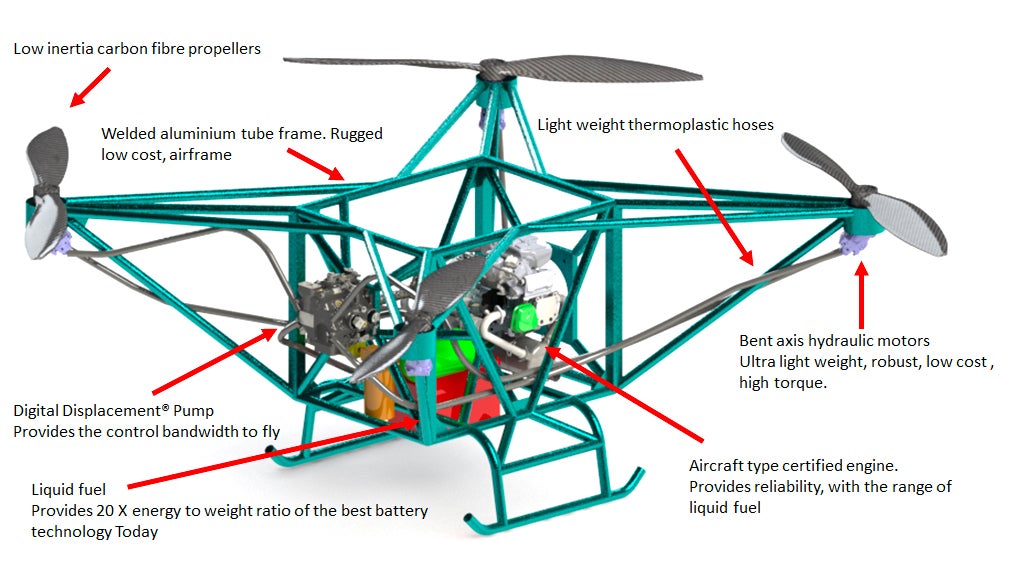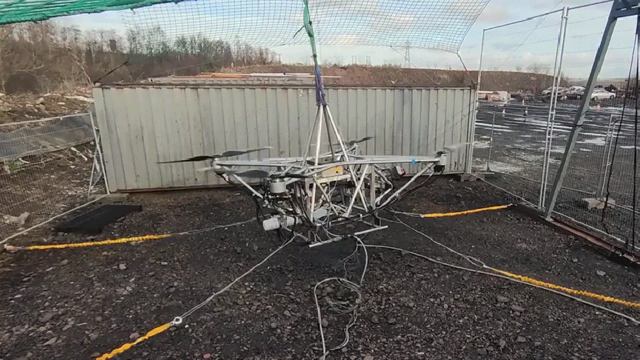It might not look perfectly stable in the air just yet, but a company called Flowcopter is building the world’s first hydraulic drone that trades batteries and electric motors for pumps and gas engines delivering a range of hundreds of miles and flight times that last hours.
There’s little doubt that someday batteries and electric motors will be up to the task of powering all the vehicles we rely on: from cars to massive container ships, even planes, but the current reality is that gasoline and other fossil fuels are much higher density fuel sources than batteries and can power motors and engines much longer with considerably less weight.
So why are there no quadcopters with tiny gas motors powering the individual rotors when the skies are full of gas-powered planes crisscrossing the globe? The problem is that gas-powered engines can’t be as precisely controlled as electric motors, and being able to immediately and accurately adjust the rotation speed of each rotor on a quadcopter is essential to stable and controllable flight. The lack of precise control isn’t an issue on a plane where a propellor or jet engine’s only job is to provide thrust in one direction, but on a quadcopter, each spinning blade needs to be constantly adjusted to counter unending wind gusts and avoid the endless pull of gravity.

A gas engine on a drone could certainly be used to power a generator that supplies power to electric motors — an approach that early electric vehicles like the Chevrolet Volt used as a backup to extend their range — but Flowcopter’s trying something entirely new. Instead of electric motors powering each propeller, hydraulic motors, powered by an endless flow of hydraulic fluid through hoses, make them spin.
The key to the drone’s promised performance — both in terms of in-air stability and its cargo-hauling capabilities — is pairing a “light aircraft type certified engine” with a Digital Displacement Pump that can control the flow of hydraulic fluid to the motors with enough precision that it rivals the performance of electric motors while offering considerably more power. Each hydraulic motor can produce up to 129 horsepower, but they weigh in at less than 5 kg each.
Flowcopter has been working on functional prototypes of its hydraulic-powered drone, and while test flights show a drone still dependent on safety tethers that’s not quite ready to haul cargo just yet, it’s an impressive proof of concept, and one that will improve as more advanced building materials are incorporated into the overall design.
The company isn’t pretending like the hydraulic motors, the Digital Displacement Pump, the gas engine, and its fuel tanks aren’t heavy, but when compared to the weight of lithium batteries and the limited range of electric drones, its hydraulic drone is a promising design. Flowcopter claims its drone could stay in the air without refuelling (or occasionally switching to non-powered gliding flight like a traditional winged aircraft can) for up to six hours and cross distances up to 900 kilometres. Shorter flights could facilitate payloads up to 150 kg, making the drone a more capable short-range autonomous delivery vehicle that doesn’t have to deal with traffic or lengthy charge times between flights.
This article has been updated since it was first published.
